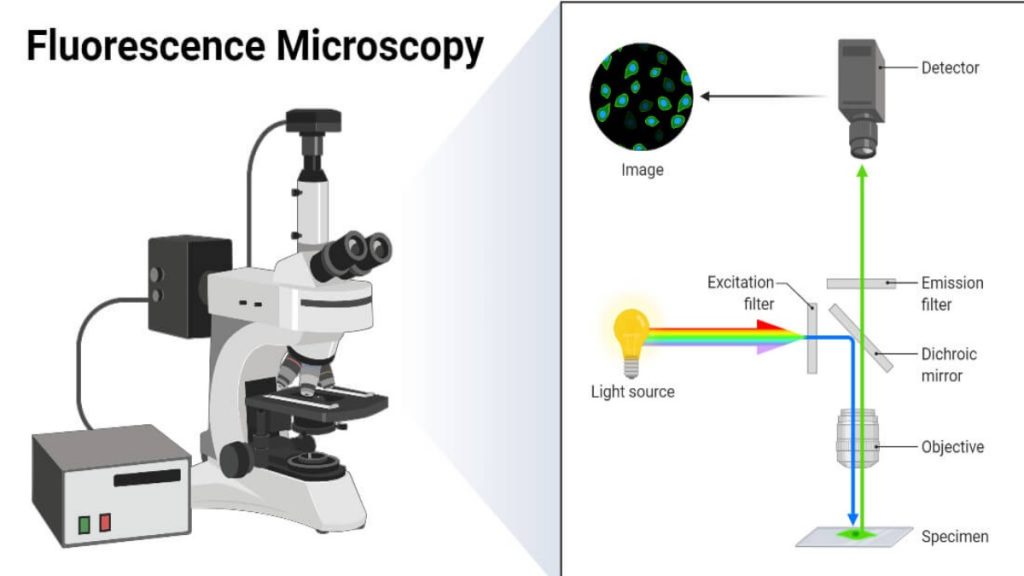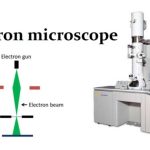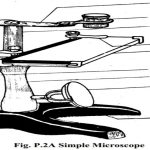- A fluorescence microscope is an optical microscope that uses fluorescence and phosphorescence instead of, or in addition to, reflection and absorption to study properties of organic or inorganic substances.
- Fluorescence is the emission of light by a substance that has absorbed light or other electromagnetic radiation while phosphorescence is a specific type of photoluminescence related to fluorescence.
- Unlike fluorescence, a phosphorescent material does not immediately re-emit the radiation it absorbs.
- The fluorescence microscope was devised in the early part of the twentieth century by August Köhler, Carl Reichert, and Heinrich Lehmann, among others.

Principle of Fluorescence Microscope
- Most cellular components are colorless and cannot be clearly distinguished under a microscope. The basic premise of fluorescence microscopy is to stain the components with dyes.
- Fluorescent dyes, also known as fluorophores of fluorochromes, are molecules that absorb excitation light at a given wavelength (generally UV), and after a short delay emit light at a longer wavelength.The delay between absorption and emission is negligible, generally on the order of nanoseconds.
- The emission light can then be filtered from the excitation light to reveal the location of the fluorophores.
- Fluorescence microscopy uses a much higher intensity light to illuminate the sample. This light excites fluorescence species in the sample, which then emit light of a longer wavelength.
- The image produced is based on the second light source or the emission wavelength of the fluorescent species — rathe rthan from the light originally used to illuminate, and excite, the sample.
Working
Light of the excitation wavelength is focused on the specimen through the objective lens. The fluorescence emitted by the specimen is focused to the detector by the objective. Since most of the excitation light is transmitted through the specimen, only reflected excitatory light reaches the objective together with the emitted light.
Forms
The “fluorescence microscope” refers to any microscope that uses fluorescence to generate an image, whether it is a more simple set up like an epifluorescence microscope, or a more complicated design such as a confocal microscope, which uses optical sectioning to get better resolution of the fluorescent image.
Most fluorescence microscopes in use are epifluorescence microscopes, where excitation of the fluorophore and detection of the fluorescence are done through the same light path (i.e. through the objective).
Instrumentation of Fluorescence Microscope
Typical components of a fluorescence microscope are:
- Fluorescent dyes (Fluorophore)
· A fluorophore is a fluorescent chemical compound that can re-emit light upon light excitation.
· Fluorophores typically contain several combined aromatic groups, or plane or cyclic molecules with several π bonds.
· Many fluorescent stains have been designed for a range of biological molecules.
· Some of these are small molecules which are intrinsically fluorescent and bind a biological molecule of interest. Major examples of these are nucleic acid stains like DAPI and Hoechst, phalloidin which is used to stain actin fibres in mammalian cells.
- A light source
· Four main types of light source are used, including xenon arc lamps or mercury-vapor lamps with an excitation filter, lasers, and high- power LEDs.
· Lasers are mostly used for complex fluorescence microscopy techniques, while xenon lamps, and mercury lamps, and LEDs with a dichroic excitation filter are commonly used for wide field epifluorescence microscopes.
- The excitation filter
· The exciter is typically a bandpass filter that passes only the wavelengths absorbed by the fluorophore, thus minimizing excitation of other sources of fluorescence and blocking excitation light in the fluorescence emission band.
- The dichroic mirror
· A dichroic filter or thin- film filter, is a very accurate color filter used to selectively pass light of a small range of colors while reflecting other colors.
- The emission filter.
· The emitter is typically a bandpass filter that passes only the wavelengths emitted by the fluorophore and blocks all undesired light outside this band – especially the excitation light.
· By blocking unwanted excitation energy (including UV and IR) or sample and system autofluorescence, optical filters ensure the darkest background.
Applications of Fluorescence Microscope
- To identify structures in fixed and live biological samples.
- Fluorescence microscopy is a common tool for today’s life science research because it allows the use of multicolour staining, labelling of structures within cells, and the measurement of the physiological state of a cell.
Advantages of Fluorescence Microscope
- Fluorescence microscopy is the most popular method fo rstudying the dynamic behavior exhibited in live cell imaging.
- This stems from its ability to isolate individual proteins with ahigh degree of specificity amidst non-fluorescing material.
- The sensitivity is high enough to detect as few as 50molecules per cubic micrometer.
- Different molecules can now be stained with different colors, allowing multiple types of molecule to be tracked simultaneously.
- These factors combine to give fluorescence microscopy a clear advantage over other optical imaging techniques, for both in vitro and in vivo imaging.
Limitations of Fluorescence Microscope
- Fluorophores lose their ability to fluoresce as they are illuminated in a process called photobleaching. Photobleaching occurs as the fluorescent molecules accumulate chemical damage from the electrons excited during fluorescence.
- Cells are susceptible to phototoxicity, particularly with short wavelength light. Furthermore, fluorescent molecules have a tendency to generate reactive chemical species when under illumination which enhances the phototoxic effect.
- Unlike transmitted and reflected light microscopy techniques fluorescence microscopy only allows observation of the specific structures which have been labeled for fluorescence.


